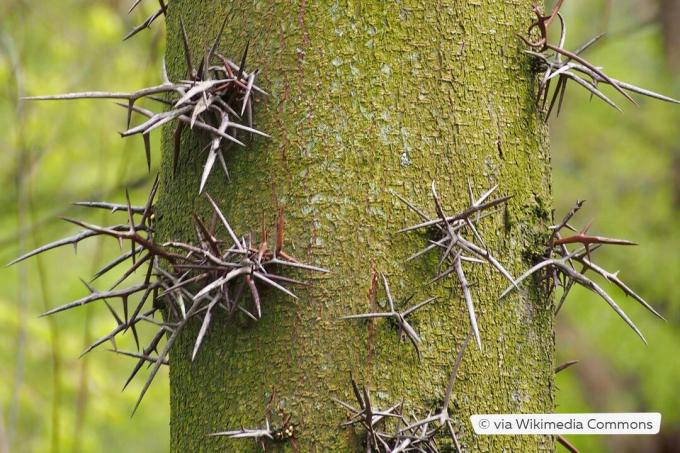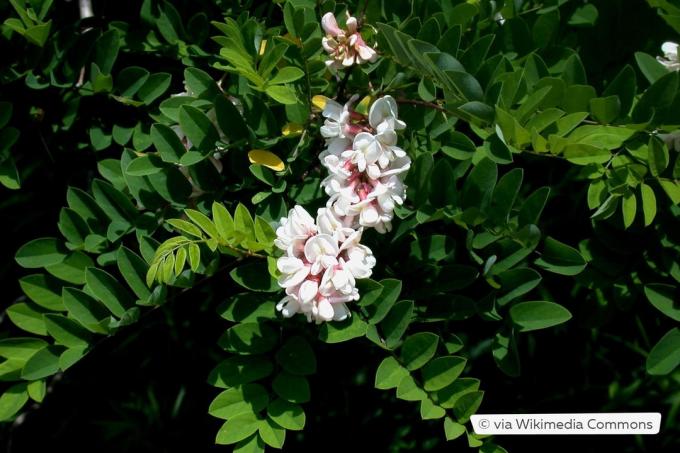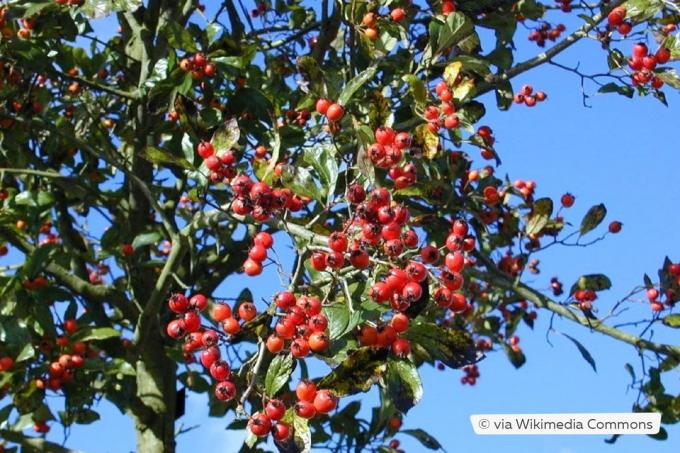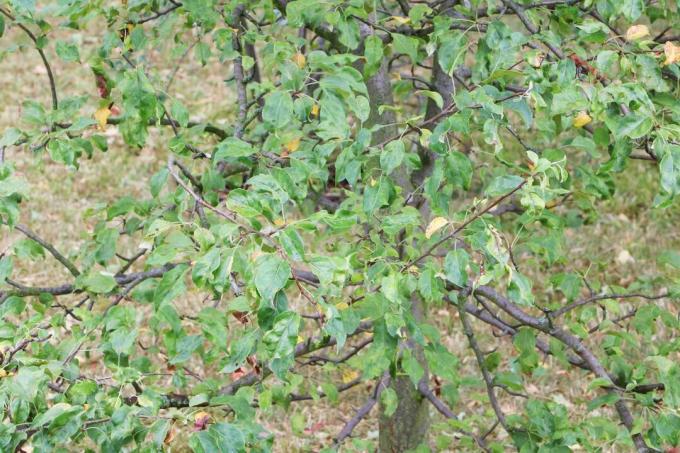
Deciduous trees with spines/thorns are among the reinforced plants. Because the pointed shoots serve to ward off enemies. Birds like to use the trees as nesting places because they naturally keep nest robbers away. You can find out which tree has thorns in this article.
To the point
- Trees form thorns/spines as protection from potential predators
- Deciduous trees have thorns/spines on the trunk and/or branches and twigs
- form individual thorns or clusters of thorns
- Exception: Holly has spines on its leaves
- The length of the sharp thorns varies between different deciduous tree species
Table of contents
- Gleditschien
- Robinia
- Holly
- Hawthorns
- Wild apple
- Wild pear
- frequently asked Questions
Gleditschien
Gleditschien (Gleditsia), also called leatherpod trees, belong to the family of legumes (Fabaceae). Most trees of this species have simple or branched thorns on the trunk and branches.
American Gleditschie

Source: Agnieszka Kwiecień, Nova, Gleditsia triacanthos Iglicznia trójcierniowa 2023-04-23 01, Edited by Plantopedia, CC BY-SA 4.0
The American Gleditsia (Gleditsia triacanthos) has simple thorns on young branches. Trunk and older branches of the Deciduous trees are covered with branched tufts of thorns that are between eight and twenty centimeters tall.
- Growth height: 800 to 2,000 centimeters
- Growth width: 500 to 2,000 centimeters
- Growth rate per year: 20 to 40 centimeters
- Location: sun
A notice: Rare thorny species of Gleditschia include Caspian, Japanese and Chinese Gleditschia. In specialist shops they are listed as rarities, if at all.
Robinia
Robinia (Robinia) are a genus of plants from the legume family (Fabaceae). Of the four recognized species, the common and sticky black locust grow as deciduous trees.
Common black locust

The fast-growing black locust Due to its botanical name “Robinia pseudoacacia” it is often also called False Acacia called. The thorns, which are up to three centimeters long, are converted stipules on the shoots (shoot thorns) of the trees. The crown and inflorescence area are mostly thornless.
- Growth height: 1,200 to 3,000 centimeters
- Growth width: 1,200 to 2,000 centimeters
- Location: sun
- Varieties: “Frisia” (thorny), “Umbraculifera” (thornless)
A notice: The not uncontroversial robinia - it is suspected to be a native species, especially in poor locations to displace - originally comes from North America, but has been in use here for almost 400 years cultivated. Its flower clusters are extremely rich in nectar and are used by bees and... Bumblebees arrived in masses.
Gold locust “Frisia”

Source: Wouter Hagens, Robinia pseudoacacia B, Edited by Plantopedia, CC0 1.0
The summer-green gold locust (Robinia pseudoacacia 'Frisia') impresses with the green-yellow color play of the leaves. In autumn the foliage turns orange-yellow. Small white flowers appear from May to June.
- Growth height: 700 to 1,000 centimeters
- Growth width: 500 to 800 centimeters
- Growth rate per year: 15 to 25 centimeters
- Location: Sun to partial shade, protected from wind
Sticky black locust

Source: Ayotte, Gilles, 1948-, Robinia viscosa 15-p.bot-robi.visc-022, Edited by Plantopedia, CC BY-SA 4.0
The sticky robinia (Robinia viscosa) grows as a small to medium-sized tree with a round to broadly egg-shaped crown. Their thorns are small. It is often described as almost thornless. The dense clusters of light pink flowers appear in June/July.
- Growth height: 600 to 1,200 centimeters
- Growth width: 500 to 600 centimeters
- Location: Sun to partial shade, protected from wind
Holly

The evergreen common one Holly (Ilex aquifolium) usually grows as a large, multi-stemmed shrub, but can also reach impressive dimensions as a tree. It is very popular with birds. What is striking here are the leathery leaves, which have spiky teeth.
- Growth height: 200 to 800 centimeters
- Growth width: 60 to 300 centimeters
- Location: partial shade to shade
A notice: For tall, older or Shady specimens have fewer spines on their leaves.
Hawthorns
Hawthorns (Crataegus) are popular hedge plants, which can also grow as small trees. Birds feel particularly safe and comfortable in them.
Grassy hawthorn

The invasive hawthorn (Crataegus monogyna) is the most common hawthorn species in Central Europe. Numerous strong thorns grow on its branches. The simple white flowers appear from May to June.
- Growth height: 600 to 1,200 centimeters
- Growth width: 100 to 300 centimeters
- Growth rate per year: 20 to 25 centimeters
- Location: Sun to partial shade, protected from wind
- Varieties: “Karmesina Plena” (double, red flowers), “Stricta” (columnar, narrow growth; simple white flowers)
Leatherleaf hawthorn

Source: VoDeTan2, Crataegus lavalei carrierei fruit, Edited by Plantopedia, CC BY-SA 3.0
The apple or leather-leaf hawthorn (Crataegus x lavallei 'Carrierei') is a breed from France. The brown-red thorns of the deciduous small tree can be up to five centimeters long. Its small white flowers with pink stamens develop into a magnificent sea of flowers in May. From summer to January, the deciduous trees bear small orange-red apple fruits.
- Growth height: 400 to 700 centimeters
- Growth width: 300 to 400 centimeters
- Growth rate per year: 20 to 40 centimeters
- Location: Sun to partial shade
hawthorn

The real hawthorn (Crataegus laevigata 'Paul's Scarlet') is a cultivated form of the two-handed hawthorn (Crataegus laevigata). It gets its name from the stuffed ones red flowers, which appear from May to June.
- Growth height: 400 to 800 centimeters
- Growth width: 300 to 400 centimeters
- Growth rate per year: 20 to 25 centimeters
- Location: Sun to partial shade
Two-handled hawthorn “Plena”
The two-handed hawthorn “Plena” (Crataegus laevigata ‘Plena’) grows as a small tree with a dense, rounded crown. The sharp thorns of deciduous trees are approximately 2.5 centimeters long. “Plena” produces double white flowers from May to June.
- Growth height: up to 1,000 centimeters
- Growth width: up to 600 centimeters
- Location: Sun to partial shade, protected from wind
Wild apple

The wild apple (Malus sylvetris) grows as a small tree with a flat crown. The flowering period is from April to May. Its apples are only edible after frost.
- Growth height: 300 to 600 centimeters
- Growth width: 200 to 400 centimeters
- Growth rate per year: 25 to 60 centimeters
- Location: Sun to partial shade
Wild pear

Source: T Kebert, Pyrus pyraster TK 2023-05-01 9, Edited by Plantopedia, CC BY-SA 4.0
The wild or wood pear (Pyrus pyraster) is the wild type of cultivated pear. The branches of wild pear trees are covered in thorns. The white flowers appear from April to May. The pear harvest begins in autumn.
- Growth height: 1,000 to 2,000 centimeters
- Growth width: 300 to 600 centimeters
- Growth rate per year: 20 to 50 centimeters
- Location: Sun to partial shade
frequently asked Questions
Spines are outgrowths that grow from the tree epidermis or the bark tissue are formed. Thorns in deciduous trees are usually converted shoot axes or shoots that are traversed by vascular bundles.
Whether the thorns are poisonous or non-poisonous depends on the tree species. If all parts of the deciduous tree are poisonous, this also applies to its thorns. Be careful when dealing with thorny trees as the thorns are extremely sharp.
Tufts of thorns on the trunk of the Gleditschie can be removed when pruning the tree. The ideal time for pruning the Gleditschie is after the leaves have fallen. The tree must not be cut in spring because it bleeds too much.

